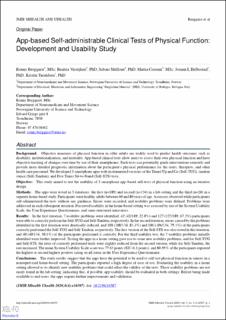| dc.description.abstract | Background: Objective measures of physical function in older adults are widely used to predict health outcomes such as disability, institutionalization, and mortality. App-based clinical tests allow users to assess their own physical function and have objective tracking of changes over time by use of their smartphones. Such tests can potentially guide interventions remotely and provide more detailed prognostic information about the participant’s physical performance for the users, therapists, and other health care personnel. We developed 3 smartphone apps with instrumented versions of the Timed Up and Go (Self-TUG), tandem stance (Self-Tandem), and Five Times Sit-to-Stand (Self-STS) tests.
Objective: This study aimed to test the usability of 3 smartphone app–based self-tests of physical function using an iterative design.
Methods: The apps were tested in 3 iterations: the first (n=189) and second (n=134) in a lab setting and the third (n=20) in a separate home-based study. Participants were healthy adults between 60 and 80 years of age. Assessors observed while participants self-administered the tests without any guidance. Errors were recorded, and usability problems were defined. Problems were addressed in each subsequent iteration. Perceived usability in the home-based setting was assessed by use of the System Usability Scale, the User Experience Questionnaire, and semi-structured interviews.
Results: In the first iteration, 7 usability problems were identified; 42 (42/189, 22.0%) and 127 (127/189, 67.2%) participants were able to correctly perform the Self-TUG and Self-Tandem, respectively. In the second iteration, errors caused by the problems identified in the first iteration were drastically reduced, and 108 (108/134, 83.1%) and 106 (106/134, 79.1%) of the participants correctly performed the Self-TUG and Self-Tandem, respectively. The first version of the Self-STS was also tested in this iteration, and 40 (40/134, 30.1%) of the participants performed it correctly. For the third usability test, the 7 usability problems initially identified were further improved. Testing the apps in a home setting gave rise to some new usability problems, and for Self-TUG and Self-STS, the rates of correctly performed trials were slightly reduced from the second version, while for Self-Tandem, the rate increased. The mean System Usability Scale score was 77.63 points (SD 16.1 points), and 80-95% of the participants reported the highest or second highest positive rating on all items in the User Experience Questionnaire.
Conclusions: The study results suggest that the apps have the potential to be used to self-test physical function in seniors in a nonsupervised home-based setting. The participants reported a high degree of ease of use. Evaluating the usability in a home setting allowed us to identify new usability problems that could affect the validity of the tests. These usability problems are not easily found in the lab setting, indicating that, if possible, app usability should be evaluated in both settings. Before being made available to end users, the apps require further improvements and validation. | en_US |
| dc.description.localcode | ©Ronny Bergquist, Beatrix Vereijken, Sabato Mellone, Mattia Corzani, Jorunn L. Helbostad, Kristin Taraldsen. Originally published in JMIR mHealth and uHealth (http://mhealth.jmir.org), 27.04.2020. This is an open-access article distributed under the terms of the Creative Commons Attribution License (https://creativecommons.org/licenses/by/4.0/), which permits unrestricted use, distribution, and reproduction in any medium, provided the original work, first published in JMIR mHealth and uHealth, is properly cited. The complete bibliographic information, a link to the original publication on http://mhealth.jmir.org/, as well as this copyright and license information must be included. | en_US |

